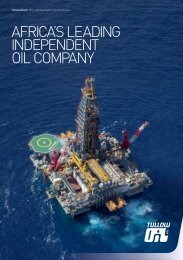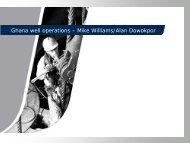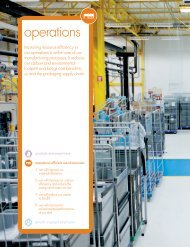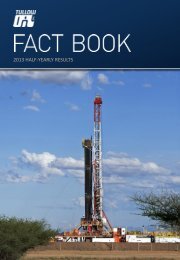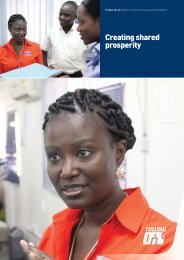Barclays plc - Annual Report 2008 - Financial statements - The Group
Barclays plc - Annual Report 2008 - Financial statements - The Group
Barclays plc - Annual Report 2008 - Financial statements - The Group
You also want an ePaper? Increase the reach of your titles
YUMPU automatically turns print PDFs into web optimized ePapers that Google loves.
Consolidated accounts <strong>Barclays</strong> PLC<br />
Accounting policies<br />
Significant accounting policies<br />
1. <strong>Report</strong>ing entity<br />
<strong>The</strong>se financial <strong>statements</strong> are prepared for the <strong>Barclays</strong> PLC <strong>Group</strong><br />
(‘<strong>Barclays</strong>’ or ‘the <strong>Group</strong>’) under Section 227(2) of the Companies Act<br />
1985. <strong>The</strong> <strong>Group</strong> is a major global financial services provider engaged<br />
in retail and commercial banking, credit cards, investment banking,<br />
wealth management and investment management services. In addition,<br />
individual financial <strong>statements</strong> have been prepared for the holding<br />
company, <strong>Barclays</strong> PLC (‘the Company’), under Section 226(2)(b)<br />
of the Companies Act 1985.<br />
<strong>Barclays</strong> PLC is a public limited company, incorporated in Great Britain<br />
and having a registered office in England.<br />
2. Compliance with International <strong>Financial</strong> <strong>Report</strong>ing Standards<br />
<strong>The</strong> consolidated financial <strong>statements</strong> of the <strong>Barclays</strong> PLC <strong>Group</strong>, and<br />
the individual financial <strong>statements</strong> of <strong>Barclays</strong> PLC, have been prepared<br />
in accordance with International <strong>Financial</strong> <strong>Report</strong>ing Standards (IFRSs)<br />
and interpretations issued by the International <strong>Financial</strong> <strong>Report</strong>ing<br />
Interpretations Committee (IFRIC), as published by the International<br />
Accounting Standards Board (IASB). <strong>The</strong>y are also in accordance with<br />
IFRSs and IFRIC interpretations as adopted by the European Union.<br />
<strong>The</strong> principal accounting policies applied in the preparation of<br />
the consolidated and individual financial <strong>statements</strong> are set out below.<br />
<strong>The</strong>se policies have been consistently applied.<br />
3. Basis of preparation<br />
<strong>The</strong> consolidated and individual financial <strong>statements</strong> have been prepared<br />
under the historical cost convention modified to include the fair valuation<br />
of certain financial instruments and contracts to buy or sell non-financial<br />
items and trading inventories to the extent required or permitted under<br />
accounting standards and as set out in the relevant accounting polices.<br />
<strong>The</strong>y are stated in millions of pounds Sterling (£m), the currency of the<br />
country in which <strong>Barclays</strong> PLC is incorporated.<br />
Critical accounting estimates<br />
<strong>The</strong> preparation of financial <strong>statements</strong> in accordance with IFRSs<br />
requires the use of certain critical accounting estimates. It also requires<br />
management to exercise judgement in the process of applying the<br />
accounting policies. <strong>The</strong> notes to the financial <strong>statements</strong> set out areas<br />
involving a higher degree of judgement or complexity, or areas where<br />
assumptions are significant to the consolidated and individual financial<br />
<strong>statements</strong> such as fair value of financial instruments (Note 50), allowance<br />
for impairment (Note 47), goodwill (Note 21), intangible assets (Note 22),<br />
and retirement benefit obligations (Note 30).<br />
4. Consolidation<br />
Subsidiaries<br />
<strong>The</strong> consolidated financial <strong>statements</strong> combine the financial <strong>statements</strong><br />
of <strong>Barclays</strong> PLC and all its subsidiaries, including certain special purpose<br />
entities (SPEs) where appropriate, made up to 31st December. Entities<br />
qualify as subsidiaries where the <strong>Group</strong> has the power to govern the<br />
financial and operating policies of the entity so as to obtain benefits from<br />
its activities, generally accompanying a shareholding of more than one<br />
half of the voting rights. <strong>The</strong> existence and effect of potential voting rights<br />
that are currently exercisable or convertible are considered in assessing<br />
whether the <strong>Group</strong> controls another entity. Details of the principal<br />
subsidiaries are given in Note 41.<br />
SPEs are consolidated when the substance of the relationship<br />
between the <strong>Group</strong> and that entity indicates control. Potential indicators of<br />
control include, amongst others, an assessment of the <strong>Group</strong>’s exposure<br />
to the risks and benefits of the SPE.<br />
This assessment of risks and benefits is based on arrangements in<br />
place and the assessed risk exposures at inception. <strong>The</strong> initial assessment<br />
is reconsidered at a later date if:<br />
a) the <strong>Group</strong> acquires additional interests in the entity;<br />
b) the contractual arrangements of the entity are amended such that the<br />
relative exposure to risks and benefits change; or<br />
c) if the <strong>Group</strong> acquires control over the main operating and financial<br />
decisions of the entity.<br />
Subsidiaries are consolidated from the date on which control is<br />
transferred to the <strong>Group</strong> and cease to be consolidated from the date that<br />
control ceases.<br />
<strong>The</strong> acquisition method of accounting is used to account for the<br />
purchase of subsidiaries. <strong>The</strong> cost of an acquisition is measured at the<br />
fair value of the assets given, equity instruments issued and liabilities<br />
incurred or assumed, plus any costs directly related to the acquisition.<br />
<strong>The</strong> excess of the cost of an acquisition over the <strong>Group</strong>’s share of the<br />
fair value of the identifiable net assets acquired is recorded as goodwill.<br />
See accounting policy 14 for the accounting policy for goodwill. A gain on<br />
acquisition is recognised in profit or loss if there is an excess of the <strong>Group</strong>’s<br />
share of the fair value of the identifiable net assets acquired over the cost<br />
of the acquisition. Intra-group transactions and balances are eliminated on<br />
consolidation and consistent accounting policies are used throughout the<br />
<strong>Group</strong> for the purposes of the consolidation.<br />
As the consolidated financial <strong>statements</strong> include partnerships where<br />
a <strong>Group</strong> member is a partner, advantage has been taken of the exemption<br />
of Regulation 7 of the Partnerships and Unlimited Companies (Accounts)<br />
Regulations 1993 with regard to the preparation and filing of individual<br />
partnership financial <strong>statements</strong>.<br />
In the individual financial <strong>statements</strong>, investments in subsidiaries are<br />
stated at cost less impairment, if any.<br />
Associates and joint ventures<br />
An associate is an entity in which the <strong>Group</strong> has significant influence,<br />
but not control, over the operating and financial management policy<br />
decisions. This is generally demonstrated by the <strong>Group</strong> holding in<br />
excess of 20%, but no more than 50%, of the voting rights.<br />
A joint venture exists where the <strong>Group</strong> has a contractual arrangement<br />
with one or more parties to undertake activities typically, though not<br />
necessarily, through entities which are subject to joint control.<br />
Unless designated as at fair value through profit and loss as set out in<br />
policy 7, the <strong>Group</strong>’s investments in associates and joint ventures are<br />
initially recorded at cost and increased (or decreased) each year by the<br />
<strong>Group</strong>’s share of the post-acquisition profit (or loss), or other movements<br />
reflected directly in the equity of the associated or jointly controlled entity.<br />
Goodwill arising on the acquisition of an associate or joint venture is<br />
included in the carrying amount of the investment (net of any accumulated<br />
impairment loss). When the <strong>Group</strong>’s share of losses or other reductions in<br />
equity in an associate or joint venture equals or exceeds the recorded<br />
interest, including any other unsecured receivables, the <strong>Group</strong> does not<br />
recognise further losses, unless it has incurred obligations or made<br />
payments on behalf of the entity.<br />
<strong>The</strong> <strong>Group</strong>’s share of the results of associates and joint ventures is<br />
based on financial <strong>statements</strong> made up to a date not earlier than three<br />
months before the balance sheet date, adjusted to conform with the<br />
accounting polices of the <strong>Group</strong>. Unrealised gains on transactions are<br />
eliminated to the extent of the <strong>Group</strong>’s interest in the investee. Unrealised<br />
losses are also eliminated unless the transaction provides evidence of<br />
impairment in the asset transferred.<br />
In the individual financial <strong>statements</strong>, investments in associates and<br />
joint ventures are stated at cost less impairment, if any.<br />
5. Foreign currency translation<br />
Items included in the financial <strong>statements</strong> of each of the <strong>Group</strong>’s entities<br />
are measured using their functional currency, being the currency of the<br />
primary economic environment in which the entity operates.<br />
Foreign currency transactions are translated into the appropriate<br />
functional currency using the exchange rates prevailing at the dates of<br />
the transactions. Monetary items denominated in foreign currencies are<br />
retranslated at the rate prevailing at the period end. Foreign exchange<br />
gains and losses resulting from the retranslation and settlement of these<br />
items are recognised in the income statement except for qualifying cash<br />
flow hedges or hedges of net investments. See policy 12 for the policies<br />
on hedge accounting.<br />
Non-monetary assets that are measured at fair value are translated<br />
using the exchange rate at the date that the fair value was determined.<br />
Exchange differences on equities and similar non-monetary items held at<br />
fair value through profit or loss, are reported as part of the fair value gain<br />
or loss. Translation differences on equities classified as available for sale<br />
financial assets and non-monetary items are included directly in equity.<br />
3<br />
<strong>Financial</strong> <strong>statements</strong><br />
<strong>Barclays</strong> PLC <strong>Annual</strong> <strong>Report</strong> <strong>2008</strong> 193




